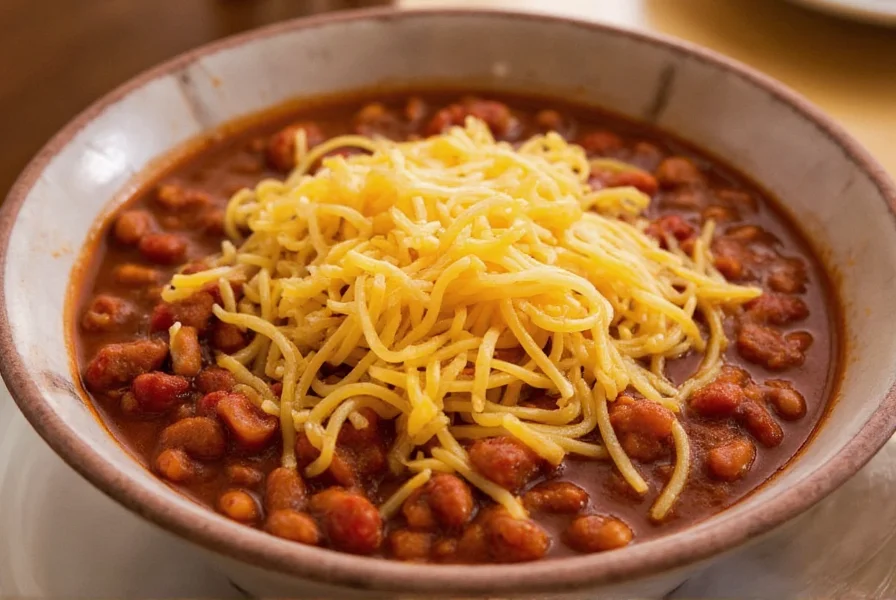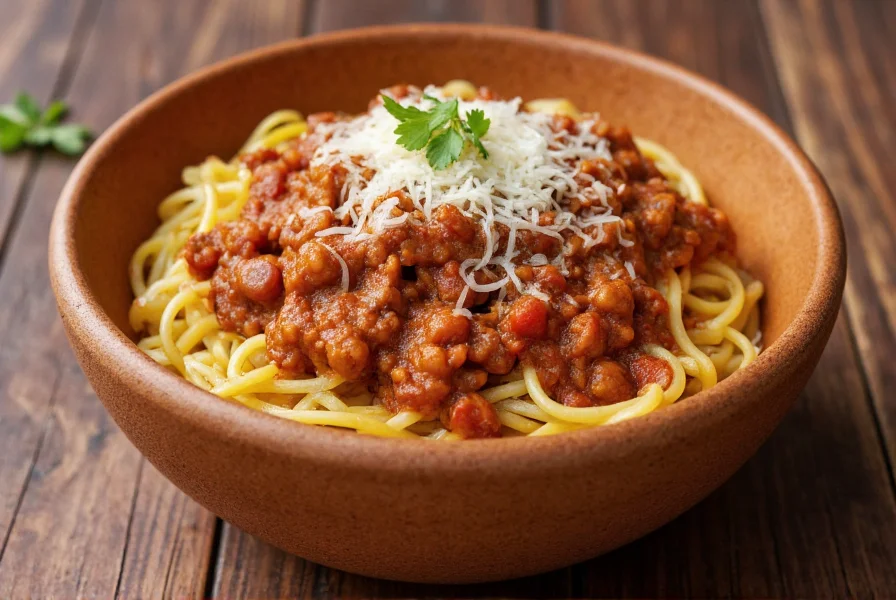Skyline Chili spaghetti represents one of America’s most distinctive regional food traditions, originating in Cincinnati during the early 20th century. Unlike traditional Tex-Mex chili, this Greek-inspired dish features a finely ground meat sauce with a complex spice profile that includes unexpected ingredients like cinnamon, allspice, and unsweetened cocoa powder. The authentic preparation method involves simmering the meat sauce for several hours to develop its signature flavor, then serving it over steaming spaghetti noodles with specific topping combinations.
The Distinctive Characteristics of Skyline Chili Spaghetti
What sets Cincinnati-style chili apart from other chili varieties is its Mediterranean-inspired seasoning profile. While conventional chili relies heavily on cumin and chili powder, Skyline Chili incorporates warm baking spices that create a subtly sweet, aromatic sauce. The meat mixture uses finely ground beef rather than chunks, resulting in a smooth texture that evenly coats spaghetti noodles. This unique Cincinnati culinary creation follows a specific “way” system for serving, with each combination representing a traditional presentation method.
| Chili “Way” | Components | Description |
|---|---|---|
| Three-Way | Chili, spaghetti, cheese | Classic combination with cheddar cheese melted over chili-topped spaghetti |
| Four-Way Onion | Three-Way + onions | Adds diced white onions for sharp contrast to sweet chili |
| Four-Way Bean | Three-Way + kidney beans | Includes kidney beans for added texture and heartiness |
| Five-Way | Chili, spaghetti, cheese, onions, beans | Complete traditional presentation with all components |
Historical Origins of Cincinnati Chili
The story of Skyline Chili spaghetti begins with Macedonian and Greek immigrants who arrived in Cincinnati during the early 1900s. Tom Kiradjieff, a Macedonian immigrant, opened the first location of what would become Skyline Chili in 1949, though the culinary tradition predates this establishment. These immigrants adapted their native meat sauces to American ingredients, creating a dish that reflected both their heritage and their new environment. The distinctive spice blend likely evolved from Mediterranean meat dishes like pastitsio, modified to appeal to American palates while maintaining cultural authenticity.

Authentic Skyline Chili Spaghetti Recipe Components
Creating genuine Cincinnati-style chili spaghetti requires attention to specific ingredients that define its unique character. The meat sauce typically includes:
- Fine-ground beef (80/20 blend)
- Tomato paste (not crushed tomatoes)
- Worcestershire sauce
- Distilled white vinegar
- Unsweetened cocoa powder
- Ground cinnamon
- Ground allspice
- Ground cloves
- Bay leaves
The precise spice ratios remain closely guarded secrets among Cincinnati chili establishments, but home cooks can approximate the flavor profile by carefully balancing these components. The sauce should simmer for at least two hours to allow flavors to meld properly, resulting in a smooth, aromatic meat sauce rather than a chunky stew.
How to Serve Skyline Chili Spaghetti Authentically
Serving Skyline Chili spaghetti correctly follows specific regional traditions that distinguish it from other chili presentations. First, prepare plain spaghetti without oil in the cooking water, as the starch helps the chili adhere to the noodles. Place the spaghetti in a shallow bowl, then ladle the hot chili over the top. The cheese component uses mild cheddar that melts smoothly when the hot chili is added. Traditional Cincinnati chili parlors use a specific technique of sprinkling shredded cheese directly onto the hot chili, allowing it to melt partially while maintaining some texture.
When recreating this Cincinnati specialty at home, maintain the proper temperature sequence: hot spaghetti, immediately topped with piping hot chili, followed by cheese that melts from the residual heat. This sequence creates the distinctive layered texture that defines authentic Skyline Chili spaghetti. Many newcomers to Cincinnati-style chili make the mistake of mixing all components together, but traditional presentation keeps the elements distinct yet complementary.
Finding Authentic Skyline Chili Outside Cincinnati
While Skyline Chili operates approximately 130 locations across five states, primarily in Ohio, Kentucky, and Indiana, fans elsewhere face challenges finding authentic versions. Several regional chains like Gold Star Chili and Dixie Chili maintain similar recipes and serving styles within the greater Cincinnati area. For those outside this region, the most reliable approach involves making homemade versions using authentic recipes that respect the traditional spice profile and preparation methods.
Misconceptions About Skyline Chili Spaghetti
Several common misunderstandings surround Cincinnati-style chili. Many assume it contains chocolate due to the cocoa powder, but the amount used is minimal—typically one to two tablespoons per pound of meat—serving only to deepen flavor without imparting chocolate taste. Another misconception suggests the dish contains cinnamon as the dominant spice, when in reality it’s part of a balanced blend where no single spice overpowers the others. Perhaps the most persistent myth claims Skyline Chili spaghetti represents a “mistake” or “inauthentic” version of chili, when in fact it represents a deliberate culinary tradition with its own distinct identity.
FAQ
What makes Skyline Chili spaghetti different from regular chili?
Skyline Chili spaghetti differs from traditional chili through its Mediterranean-inspired spice profile featuring cinnamon, allspice, and cocoa powder rather than heavy chili powder. It uses finely ground beef instead of chunks, has a thinner consistency, and is specifically designed to be served over spaghetti with cheese, onions, and beans in defined combinations called “ways.”
Does Skyline Chili actually contain chocolate?
No, authentic Skyline Chili does not contain chocolate. It includes a small amount of unsweetened cocoa powder (typically 1-2 tablespoons per pound of meat) which serves to deepen the flavor and enhance the meatiness without imparting any chocolate taste. The cocoa works as a flavor enhancer rather than a primary ingredient.
What does “Three-Way” mean when ordering Skyline Chili spaghetti?
In Cincinnati chili terminology, a “Three-Way” refers to the classic combination of chili, spaghetti, and shredded cheddar cheese. The “way” system describes specific topping combinations: Four-Way adds either onions or beans, while Five-Way includes chili, spaghetti, cheese, onions, and beans together.
Can you make authentic Skyline Chili spaghetti at home?
Yes, you can create a close approximation of Skyline Chili spaghetti at home by using fine-ground beef, tomato paste, and the distinctive spice blend of cinnamon, allspice, cloves, and unsweetened cocoa powder. The key is simmering the sauce for several hours to develop flavors and serving it properly over spaghetti with the traditional toppings in the correct sequence.
Why is Skyline Chili served over spaghetti?
Serving chili over spaghetti reflects the Macedonian and Greek immigrant heritage of Cincinnati chili's creators, who adapted their traditional pastitsio (a baked pasta dish with spiced meat sauce) to American ingredients. The spaghetti provides a neutral base that allows the complex spice profile of the chili to shine while creating a satisfying, hearty meal that became popular during the Great Depression.











 浙公网安备
33010002000092号
浙公网安备
33010002000092号 浙B2-20120091-4
浙B2-20120091-4